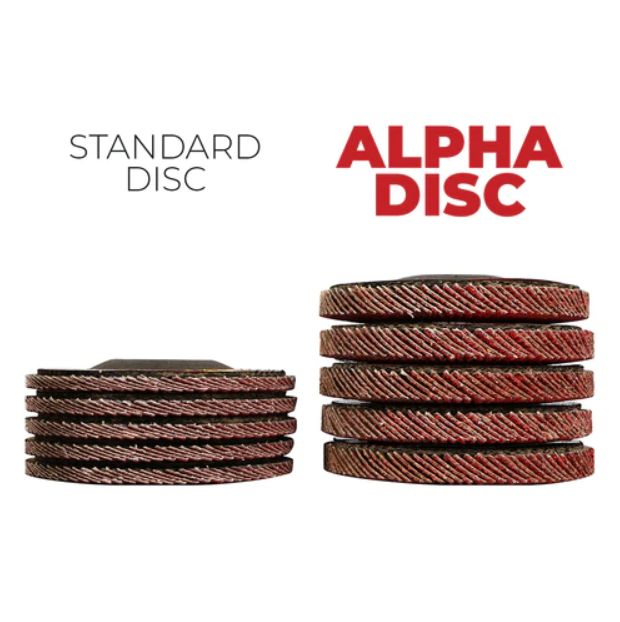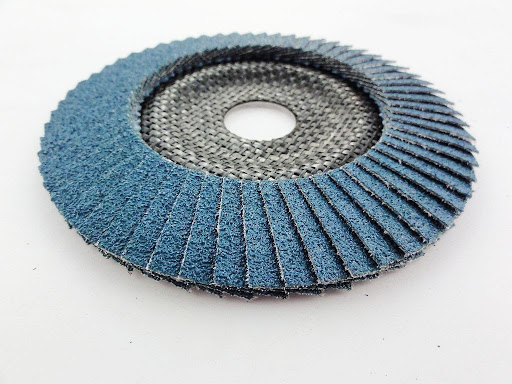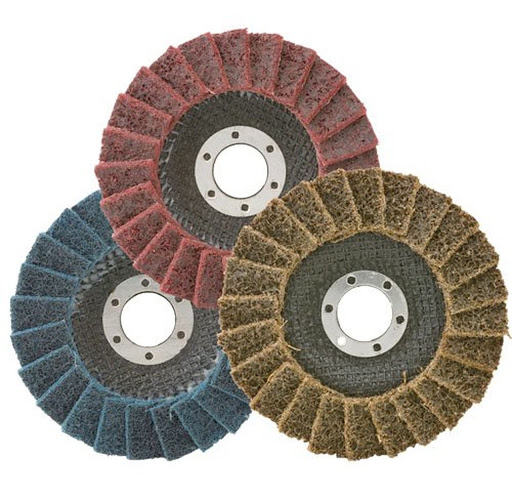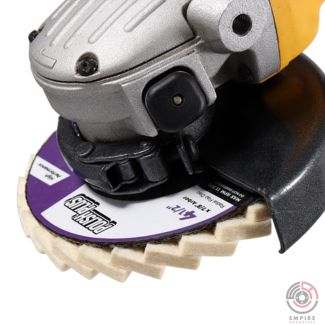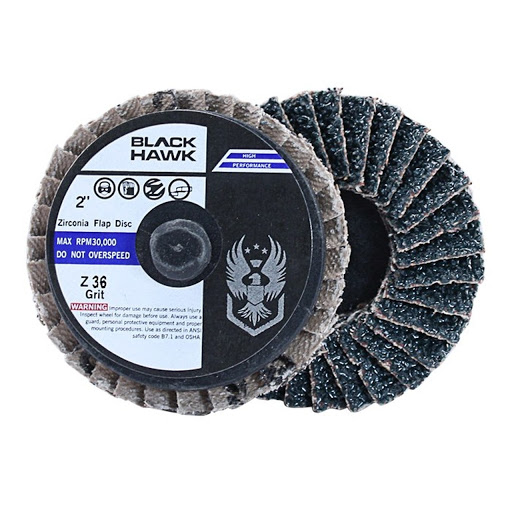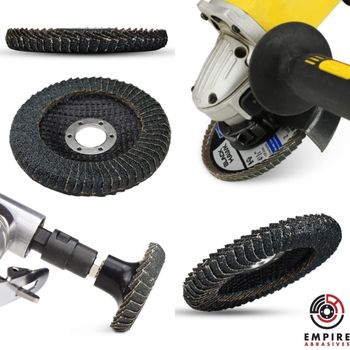
What is a Flap Disc?
Not to be confused with a flap wheel, a flap disc is an abrasive disc designed to work with angle grinders and die grinders. They are made up of overlapping coated abrasive flaps attached radially to a backing plate often made up of fiberglass or plastic and featuring either an open center hole, screw on-screw off hub, or quick change attachment.
The overlapping layers make it so that when one layer is worn down, a fresh abrasive sheet is immediately available to continue work without needing to change out tools. Unlike grinding wheels and resin fiber discs, flap discs offer more versatility and smoother results. Flap discs alone are capable of doing a lot of work that would require switching back and forth between other types of grinding and sanding discs.
Benefits of Flap Discs Versus Grinding Discs
- Lighter pressure needed to achieve results
- Less vibration and noise than a grinding wheel
- Cooler grinding temperatures
- Cost-effective
- Last longer than fiber discs
- Consistent rate of stock removal
- Lightweight and easy to maneuver
- Less gouging than other discs
- Provides maximum contact with work surface
What are Flap Discs Used For?
Flap discs provide an efficient and economical option for grinding, blending, and finishing with a single tool. They are a popular tool among metal workers and welders but have uses on other surfaces as well. With the right choice, you will save yourself a great deal of time and effort.
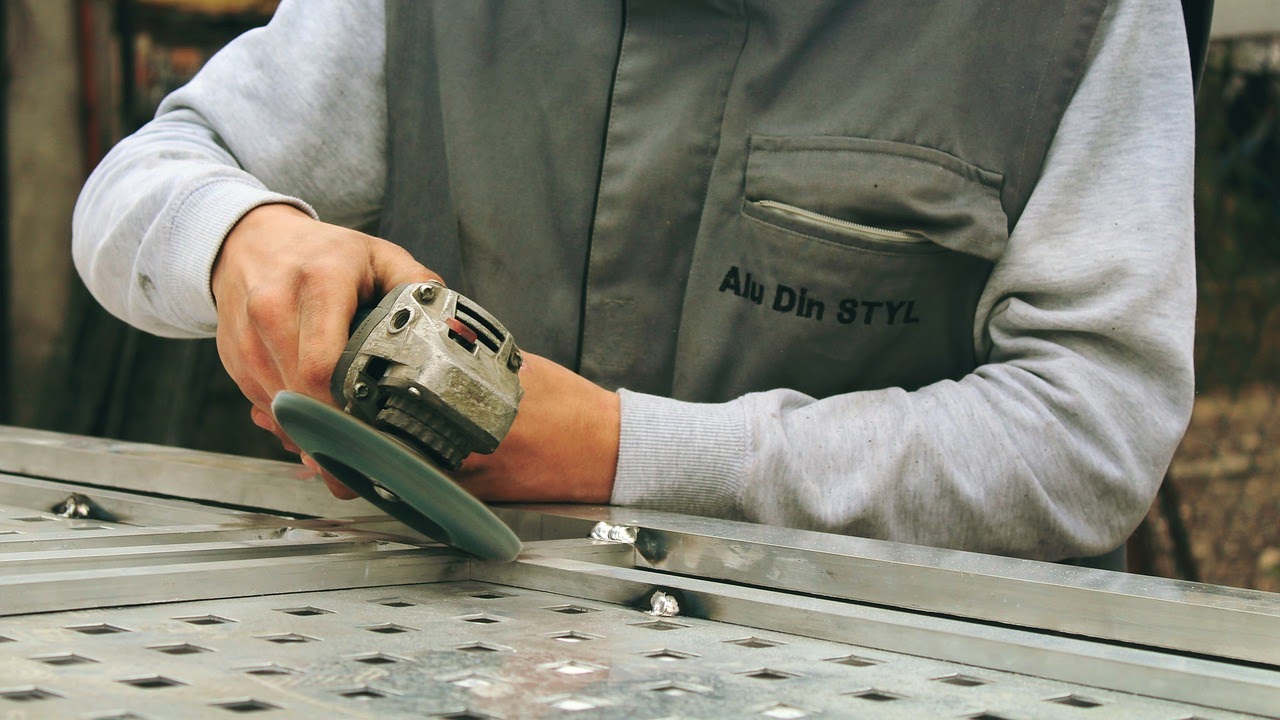
They aren’t just meant for metalwork though. For example, they are handy tools for carpentry and furniture restoration projects to smooth rough edges on wooden surfaces. With concrete jobs, flap discs can help with surface preparation, such as removing paint or smoothing rough patches before sealing.
Common Flap Disc Uses
- Fast weld and stock removal in metal fabrication use
- Blending of a weld
- Deflashing
- Blending or finishing metal surfaces
- Deburring steel and stainless steel
- Paint and rust removal
- Smoothing and shaping wood
- Concrete polishing and edge work
- (Certain discs) Shining and polishing
- Edge chamfering
Choosing the Right Flap Disc for Different Materials and Projects
Selecting the correct flap disc depends on the material you're working with and the task you plan on tackling. These discs are typically made with sanding sheets coated with aluminum oxide, zirconia, silicon carbide or ceramic abrasive grains, but also come in non-woven surface conditioning material, interleaf and felt (non-abrasive) varieties. The most common flap discs are made of zirconia for grinding and finishing in one step. They are usually available in 40, 60, 80, or 120 grit which the operator would select depending on their material or project goal.
You’ll want to choose a disc with an abrasive grain that effectively grinds the type of surface you’re working on. Choosing the right grit is important based on the outcome you are looking to achieve. For example, you’ll want a coarse grit zirconia flap disc to grind metal and remove excess material. On the other hand, you might want to consider a gentler non-woven flap disc to blend a surface without damaging the underlying material.
Standard VS High Density Alpha Discs
Flap Discs come in a variety of sizes, grits, and materials as we all know. The most common material used is zirconia because of its reliability and multi-purposed benefits. When looking through all of your options, you will notice one difference when browsing through zirconia flap discs - a standard or high density option.
Standard density is exactly what you expect - the basic thickness zirconia flap disc. These are typically made with 72 flaps that measure between 16mm and 18mm in length and between 22mm and 25mm in width. High density flap discs on the other hand feature 86 flaps or greater, depending on the grit, with each flap measuring between 20mm and 22mm in length, and between 25mm - 27mm in width.
The most elite and long lasting option of the high density flap discs are the extra large BHA Alpha Ceramic Flap Discs. This beefy, extra large flap disc combines the increased material of a high density flap disc with the technological superiority of premium polyester flaps and ceramic abrasive grains.
T27 vs T29 Flap Discs
Besides grit size, abrasive material, and flap disc backing plates, the other thing to consider when shopping for flap discs is whether you need a type 27 (A.K.A. T27 or a type 29 (A.K.A. T29 ) flap disc. These “types” delineate a shape that the flaps are arranged in which offer different benefits when used on an angle grinder. There will be more detail below but in short, the T27’s have flat flaps where the T29’s offer a slight angle. As previously stated both offer some benefits but the differences are subtle enough that many users will typically decide which type based on preference.
T27 Flap Discs - Flat
Type 27, or T27 flap discs, are a flat-shaped abrasive. They provide no angle which makes these better for detailed work as opposed to the fast material removal that T29 discs provide.
T27 discs are best for jobs that require blending and smooth finishing on flat surfaces. They are also better suited for working on more intricate surfaces. This type of flap disc should be used at 0°-15° angle.
T29 Flap Discs - Conical
Type 29, or T29 flap discs, are designed with a conical or angled shape. Instead of lying flat, the edges flare out, angled at 10 degrees. This angle also allows the tool to create a larger surface contact area on flat surfaces.
T29 discs are best used for aggressive heavy-duty stock removal, on contoured surfaces, and edge work. Type 29 flap discs should be used at 15°-25° angle.
For more information, read our full guide to type 27 vs type 29 discs.
Types of Specialty Flap Discs
Standard flap discs are versatile tools, but specialty flap discs like the ones below take their usefulness a bit further by targeting specific materials and grinding tasks. Whether you’re working with soft metals like aluminum, polishing surfaces to a high shine, or navigating tight spaces, there’s a specialty flap disc designed to make the job easier. Below, we explore several types of specialty flap discs, including those made for aluminum, surface conditioning, polishing, and more, so you can choose the right tool for your unique project needs.
Flap Discs for Aluminum
Since aluminum is a softer metal, it provides an interesting set of obstacles. For one thing, aluminum can be ground away more easily, so you must be careful of gouging your workpiece. Secondly, the aluminum may “gum up” or clog the abrasive as it wears away. This will significantly shorten the useful life of your flap disc and potentially damage the aluminum from too much heat building up. Both of these issues can be easily mitigated by using the correct disc.
A flap disc such as BHA Flap Disc for Aluminum features a calcium stearate coating which not only protects the workpiece from heat and inconsistent grinding but also prevents loading of the disc which increases the lifetime of the disc.
Just as any other flap discs, these are also offered in a T27 and T29. As previously mentioned the main differences between these two types is the shape. While the T27 is flat the T29 is angled for different types of grinding and finishing.
Surface Conditioning Flap Discs
Surface Conditioning flap discs combine the best of two worlds. They offer the benefits of standard flap discs design which exposes new effect abrasives as old abrasives are worn down, with the flexible surface preparation capabilities of non-woven materials. This means they not only blend and clean surfaces effectively but they also last an extremely long time compared to standard, flat, surface conditioning discs.
These discs are available in coarse (tan color), medium (red - maroon color), or fine (blue color) and work well when used on stainless steel, standard or alloyed steel, non-ferrous metals and alloys, plastic, and even fiberglass.
Felt Polishing Flap Discs
While flap discs are generally constructed using an abrasive, typically one made of pieces of sandpaper, some discs are better equipped for the finer things in life (get it?). Jobs for polishing and extremely fine finishing require an even finer flap material to get glossier polish without using abrasive materials. The new BHA polish plus discs offer just the thing with felt material flaps that are perfect for final stage polishing.
Instead of having a rough abrasive like ceramic or zirconia, felt flap discs are made with a strong Australian wool. This is a flexible and forgiving material that works on almost any surface with polishing pastes or buffing compounds to provide the best end-results possible.
Mini Flap Discs
Sometimes an angle grinder isn’t always available for use, you have a job requiring more detailed work, or the job is too small to require a full size flap disc. That’s where mini flap discs come in - perfect for a die grinder. They come with all the benefits and versatility of a flap disc but now come in a smaller size and a roloc, quick change backing for use in smaller or tight areas.
Mini quick change flap discs create less loading during use than standard quick change sanding discs creating a more consistent grind. The flap disc construction also expands the lifetime between 10-20 times longer than standard discs. These discs are offered in a 2 inch or 3 inch size and are great for stock removal, finishing and polishing, and blending all in tight areas.
Curved/Rounded Edge Flap Discs
Generally speaking, a flap disc is one of the most versatile abrasive products given their affordability, durability, and grinding abilities. That being said, one of the reasons a metalworker or welder would consider grinding wheels over a flap disc would be the ability for a grinding wheel to grind into tight corners and fillet welds. This is because the grinding surface area of a grinding wheel is around the edge of the disc, which allows it to reach those areas, which a regular flap disc can't.
A new specialty flap disc has been designed to increase the grinding area of a flap disc by wrapping the abrasive material around the edges. These rounded edge/curved flap discs can grind on the face of the disc PLUS using the rounded edge to get into those tight areas.
Flap Disc FAQ
What is a flap disc used for?
- Flap discs are used for grinding, smoothing, and finishing tasks on various materials, including metal, wood, and plastic.
What tool uses flap discs?
Flap discs are designed to be used with die grinders and different sized angle grinders.
What is the difference between a sanding disc and a flap disc?
A sanding disc has a single layer of abrasive material, while a flap disc has multiple overlapping flaps that provide longer-lasting grinding and finishing capabilities.
How long should a flap disc last?
The lifespan of a flap disc depends on usage, material, and pressure. Generally, they last longer than standard grinding discs but should be replaced when the abrasive is worn down or performance diminishes
Do flap discs remove metal?
Yes, flap discs are designed to remove metal efficiently, especially for tasks like deburring, weld removal, and surface preparation.
Can flap discs be used on wood?
Yes, flap discs can be used on wood for tasks like smoothing, shaping, and removing old finishes. Opt for a finer grit to avoid gouging the wood.
What grit flap disc should I use for metal?
For heavy material removal, use a coarser grit like 40 or 60. For finishing, go with finer grits like 80 or 120.
How do I prevent flap discs from wearing out quickly?
Choose the right disc for the material based on what you’re working on and your project goals. Avoid excessive pressure to extend disc life.
What’s the difference between T27 and T29 flap discs?
T27 discs are flat and best for detailed finishing at low angles (0°–15°). T29 discs are conical and angled (~10° outward), offering more aggressive stock removal and better for contours or edge work. Use them at steeper angles (15°–25°).
Can I use the same flap disc on multiple materials?
Like other abrasive products, it’s best to use separate flap discs for different materials to maintain quality and avoid cross-contamination. For example, if you're considering using the same flap disc on multiple materials, such as stainless steel and wood, it's not recommended. Using a flap disc on metal first can embed metal particles in the abrasive, which could then transfer to the wood and potentially cause contamination, scratches, or uneven results.
Are flap discs good for removing rust?
Yes, flap discs are excellent for rust removal, providing a clean and smooth surface for further treatment or painting
Chat With Our Team of experts
Not completely positive what discs you need for your projects? Chat with one of our experts today. Find our chat in the bottom right of our website or fill out our contact form.
Order Flap Discs Today!
Are you ready to try these versatile flap discs for yourself? Browse our wide selection of flap discs today and get your orders shipped out within one business day.

